◆Bird's Eye View about Castle and City in Edo Period◆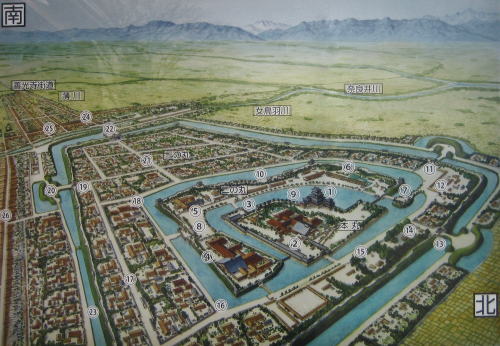
⇒Enlarged picture
⇒Picture of Nawabari of tte castle
|
Nawabari means a concept about total defence system involving downtowns encircling the castle.
The picture on the left side, which is set in front of a turret beside Kuromon of Honmaru, shows us the feature of the castle and the downtowns.
The place where the castle is standing was a central area of swamps and lakes long ago. Huge water came down there from the mountains or highlands surrounding Matsumoto Basin through several rivers.
The moats for defence of the castle were made by digging the
bottom and they raised up mud to make the base of the castle and the towns,
letting water flow into the moats.
Thus the Nawabari with rich water were formed.
|
|
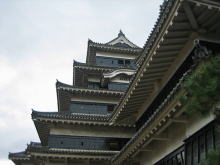
◆Structures for Defence◆
War is over when the enemy would capture the main tower. Therefore the main tower has many structures for driving out the enemy approaching it.
The earthworks and the stone-walls have a lot of corners and curves to form Yokoya-gakari. It means that they would shoot guns and arrows down from the edges or protrusions of the stone -walls or the earthworks, to hinder the enemy rushing.
The walls of each storey have many holes called Ya-zama and Teppo-zama through which they would shoot. And the lowest storey's walls have box-rooms called Ishi-otoshi.
There are very a few windows on the walls. Every window is attached strong wooden grids. Such windows is called Musha-mado.
Thus the main tower has so rude structures that they couldn't use it for daily administration. It looks like, so to speak, a hedgehog facing a predator. In the peace time it functioned as a symbol of the military authority of the clan-lord.

bottles for fire powder
◆Tower as Weapon Warehouse◆
From the reasons mentioned above, the main tower-complex was a weapon warehouse for wartime. It was functionless in ordinary time.
In the war age they managed to keep it by consuming a great deal of resouces. Matsumoto Castel was built in the late war age, it has had such a military character.
In a way from such a background, the main tower is now a museum displaying the weapons used or developed in the war age. That is inevitable as a museum to show its own history as a military apparatus.
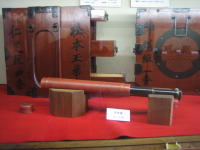
a telescope
◆Moats and watching tower◆
A tall structure of the tower gives a good perspective. From the high view point of the tower, we could realize the role of the moats preventing it from attack or approach of the enemy.
High towering and the moats would be very effactive denfence apparat.
By the way the castle, especially the main tower needs not only rudeness of the military apparatus, but also the elegantness of outlook to show some authority or dignity.
It must have some kind of decorativeness to represent the majasty of the lord.
As the castle was built in the latter phase of the war age, it has had some gracefulness that would be inherited to the later age.
For example of such a decorative display, Shachi-hoko of the top roof or Chidori-hafu gable.
■Staff in Yoroi armour■
On the way from the main tower I met a young staff in armour of Japanese Samurai. He took a pose for a photograph in front of the main tower.
To the question I asked about the weight of the armour, he answered that it was over 20 kilograms. His service welcoming visitors is very hard work.
See the picture on the right hand.
|
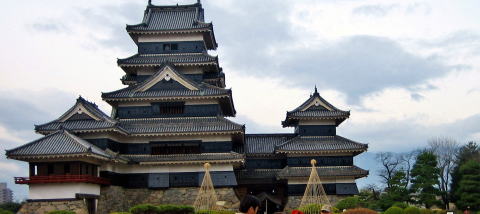
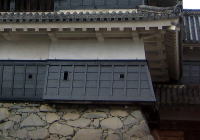
The rudeness of the war age and the calmness of the peace time coexist in the main tower-comlex.
On the walls of towers Ishiotoshis, through which they would throw down stones or lances againt the enemy soldiers rushing onto the stone-wall, are attached.
The walls have the holes called Ya-zama or Teppo-zama through which they would shoot guns or arrows.
However, Tsukimi-yagura, i.e. the moon-watching turret, has a structure in which they would enjoy the moon and the landscape outside without armours.
Thereafter the castle change its function from the war apparatus into the symbol of the peaceful governance under Pax Tokugawa.
|
